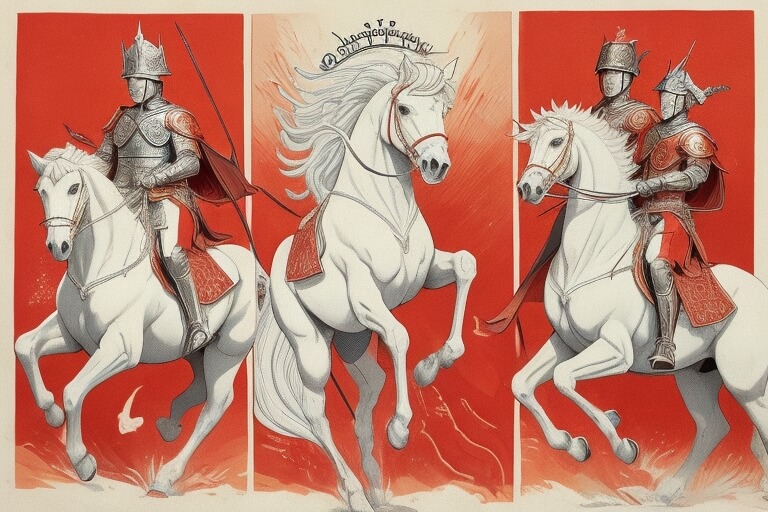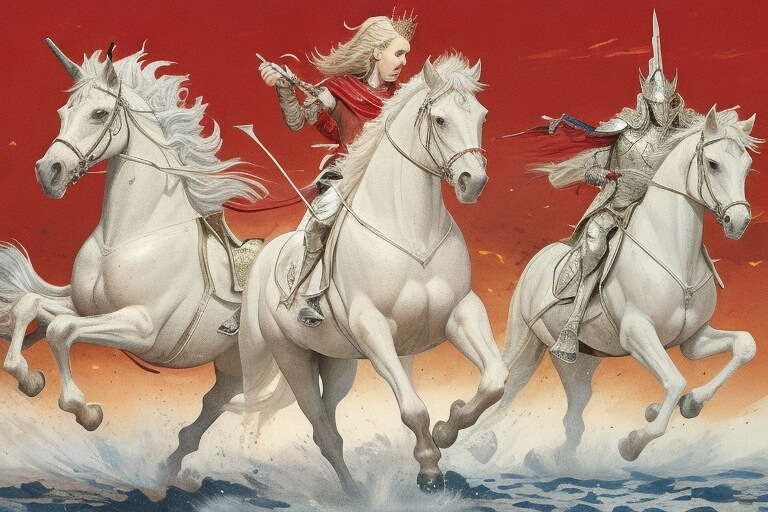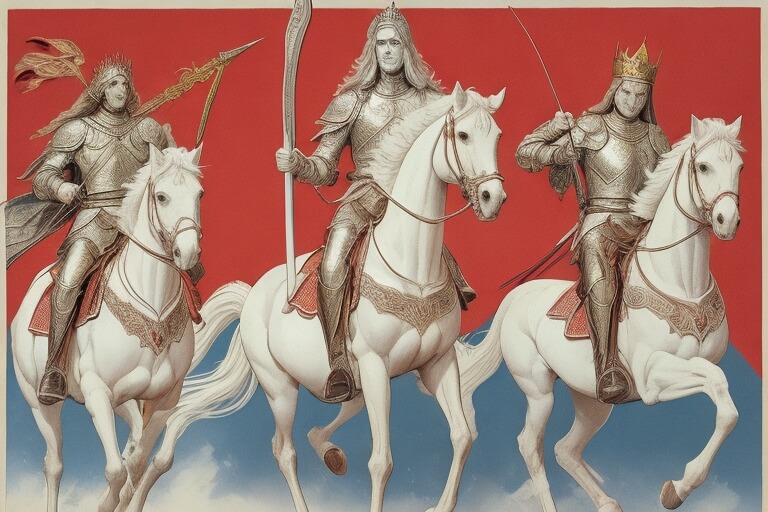Discover the origins, symbolism, and cultural impact of the Four Horsemen of the Apocalypse. Explore their significance in literature, mythology, and popular culture, and learn how they represent themes of judgment, chaos, and the end times in various traditions.

The Four Horsemen of the Apocalypse are symbolic figures described in the Christian Bible, specifically in the Book of Revelation, which is the final book of the New Testament. They are associated with the end times and are often interpreted as harbingers of divine judgment and the apocalypse. Each of the Four Horsemen represents a different aspect of this cataclysmic event. The Four Horsemen are:
- The White Horse: This horseman is often associated with conquest or, in some interpretations, the Antichrist. The rider carries a bow and is crowned, symbolizing power and authority. The white color is typically seen as representing purity or deception.
- The Red Horse: This horseman is associated with war and bloodshed. The rider carries a sword, and the red color of the horse signifies the violence and chaos of warfare.
- The Black Horse: This horseman is often associated with famine. The rider carries scales, symbolizing the scarcity of food and the economic hardships that accompany famine. The black color of the horse represents death and suffering.
- The Pale Horse: This horseman is often associated with death and pestilence. The rider is named Death, and Hades (the realm of the dead) follows closely behind. The pale or sickly green color of the horse symbolizes disease and death sweeping through the land.
The appearance of the Four Horsemen in the Book of Revelation is part of a series of apocalyptic events and visions foretelling the end of the world and the final judgment by God. They are sent as part of God’s divine plan to bring about judgment and the ultimate renewal of the world. Their symbolism has been the subject of various interpretations and discussions throughout history, and different religious traditions may offer slightly different interpretations of their significance.
It’s important to note that interpretations of the Book of Revelation and the Four Horsemen can vary widely among Christian denominations and scholars. Additionally, these symbols have also influenced literature, art, and popular culture, sometimes taking on broader cultural meanings beyond their original religious context.
What is the symbolism of the Four Horsemen and what events do they represent?
The Four Horsemen of the Apocalypse are rich in symbolism, and their appearance in the Book of Revelation is often interpreted as representing various events and aspects of the end times and divine judgment. Here is a breakdown of their symbolism and the events they are believed to represent:
- The White Horse (Conquest or the Antichrist):
- Symbolism: The white horse represents conquest, power, and authority. The rider wears a crown, signifying leadership and dominion, and carries a bow, which can symbolize warfare or the potential for conflict.
- Events Represented: This horseman’s appearance may symbolize the rise of a conqueror or a force that seeks to dominate the world. In some interpretations, this rider is associated with the Antichrist, a figure of great deception and opposition to God.
- The Red Horse (War):
- Symbolism: The red horse symbolizes war, violence, and bloodshed. The rider carries a sword, which is a clear symbol of conflict and destruction. The red color of the horse represents the spilling of blood.
- Events Represented: This horseman’s appearance signifies widespread warfare and strife during the end times, bringing chaos and suffering to the world.
- The Black Horse (Famine):
- Symbolism: The black horse represents famine and economic hardship. The rider carries scales, symbolizing the scarcity of food and resources. The black color signifies death and suffering.
- Events Represented: This horseman represents food shortages, economic collapse, and widespread hunger, leading to suffering and desperation.
- The Pale Horse (Death and Pestilence):
- Symbolism: The pale horse symbolizes death and pestilence (disease). The rider is named Death, and Hades (the realm of the dead) follows closely behind. The pale or sickly green color of the horse represents illness and death.
- Events Represented: This horseman represents widespread death and disease, likely as a result of the preceding events such as war and famine. It signifies a grim and devastating phase of the end times.
These Four Horsemen are often seen as instruments of divine judgment, sent by God to bring about the culmination of history and the final reckoning. They are a recurring theme in apocalyptic literature and have been interpreted in various ways throughout Christian history and in different theological traditions. While these interpretations may vary, the common theme is that they herald significant and catastrophic events that are part of God’s plan for the end of the world and the ultimate establishment of His kingdom.
What do we know about the origins and history of the Four Horsemen?
The origins and history of the Four Horsemen of the Apocalypse can be traced primarily to the Christian Bible, specifically the Book of Revelation (also known as the Apocalypse of John), which is the final book of the New Testament. The Book of Revelation is traditionally attributed to the Apostle John and is believed to have been written in the late first century CE, likely around 95-96 CE, during a period of Roman persecution of Christians.
The Four Horsemen are introduced in Revelation 6:1-8, and this passage serves as their primary biblical reference:
Revelation 6:1-8 (New International Version):
1 I watched as the Lamb opened the first of the seven seals. Then I heard one of the four living creatures say in a voice like thunder, “Come!” 2 I looked, and there before me was a white horse! Its rider held a bow, and he was given a crown, and he rode out as a conqueror bent on conquest. 3 When the Lamb opened the second seal, I heard the second living creature say, “Come!” 4 Then another horse came out, a fiery red one. Its rider was given power to take peace from the earth and to make people kill each other. To him was given a large sword. 5 When the Lamb opened the third seal, I heard the third living creature say, “Come!” I looked, and there before me was a black horse! Its rider was holding a pair of scales in his hand. 6 Then I heard what sounded like a voice among the four living creatures, saying, “Two pounds of wheat for a day’s wages, and six pounds of barley for a day’s wages, and do not damage the oil and the wine!” 7 When the Lamb opened the fourth seal, I heard the voice of the fourth living creature say, “Come!” 8 I looked, and there before me was a pale horse! Its rider was named Death, and Hades was following close behind him. They were given power over a fourth of the earth to kill by sword, famine and plague, and by the wild beasts of the earth.
The Book of Revelation is a highly symbolic and apocalyptic text, filled with vivid imagery and visions. The Four Horsemen are just one part of a larger narrative describing the end times and the final judgment. The specific symbolism and interpretation of these horsemen have evolved over the centuries and have been subject to various theological perspectives and cultural influences within Christianity.
It’s worth noting that the concept of horsemen as agents of divine judgment has some parallels in other ancient Near Eastern and biblical literature, but the specific presentation of the Four Horsemen as described in Revelation is unique to the Christian tradition.
Over time, the Four Horsemen have become iconic symbols of apocalyptic events and have appeared in various forms in Christian art, literature, and popular culture, contributing to their enduring significance in Western cultural and religious history.

What are the variations of the Four Horsemen in different cultures?
The concept of apocalyptic horsemen as harbingers of doom and divine judgment is not exclusive to Christianity. Similar themes and symbols have appeared in various cultures and religions around the world, although the specific details and interpretations vary widely. Here are a few examples of similar figures in different cultures:
- Ancient Near East and Mesopotamia:
- In Mesopotamian mythology, there are references to divine beings associated with the release of destructive forces, often symbolized as “Seven Apkallu” or “Seven Sages.” While these beings are not horsemen per se, they play a role in apocalyptic or cataclysmic events.
- Norse Mythology:
- In Norse mythology, there is a belief in the coming of “Ragnarök,” a series of events that bring about the end of the world. While not explicitly horsemen, figures such as the wolf Fenrir and the serpent Jörmungandr are associated with chaos and destruction during this cataclysmic event.
- Hinduism:
- In Hinduism, the god Shiva is often associated with both destruction and creation. His dance, known as the “Tandava,” represents the cyclical destruction and renewal of the universe. While not depicted as horsemen, the concept of divine destruction aligns with apocalyptic themes.
- Native American and Indigenous Beliefs:
- Various Native American and indigenous cultures have their own beliefs about the end of the world or cataclysmic events. These often involve natural elements, spirits, or mythological beings associated with upheaval and change.
- Zoroastrianism:
- In Zoroastrianism, an ancient Persian religion, there is a belief in the arrival of a savior figure known as the “Saoshyant” who will lead the final battle against evil forces, marking the end of the world as it is known.
- Buddhism:
- While Buddhism generally focuses on individual enlightenment and liberation from suffering, some Buddhist traditions have eschatological beliefs related to the end of the world. These beliefs can vary significantly among different Buddhist schools.
It’s important to note that while there are similarities in the themes of apocalyptic events and figures in various cultures, the details, interpretations, and cultural contexts differ greatly. The Four Horsemen of the Apocalypse, as described in Christian tradition, are a specific and unique representation of these themes within the context of the Book of Revelation. The symbolism and interpretations of these figures are deeply rooted in Christian theology and have had a profound impact on Western culture and literature.

What is the significance of the Four Horsemen in literature and popular culture?
The Four Horsemen of the Apocalypse hold significant cultural and literary importance due to their vivid symbolism and association with apocalyptic themes. They have been a source of inspiration for writers, artists, filmmakers, and creators in various forms of media. Here are some key aspects of their significance in literature and popular culture:
- Symbolism of Apocalypse: The Four Horsemen embody the concept of the end times and the impending apocalypse, making them powerful symbols of the ultimate reckoning or judgment day. Their presence in a story or artwork can evoke a sense of impending doom and chaos.
- Moral and Ethical Themes: The Four Horsemen often represent moral and ethical dilemmas. They can serve as allegorical figures, highlighting the consequences of human actions, such as war, famine, and pestilence, and encouraging reflection on the consequences of those actions.
- Narrative Conflict: In literature and storytelling, the Four Horsemen can be used as antagonistic forces that drive the plot and create conflict. Authors may use them as catalysts for dramatic events and character development.
- Artistic Inspiration: The vivid and striking imagery of the Four Horsemen has inspired countless artists and illustrators. Their depiction in paintings, sculptures, and other visual media is a testament to their enduring visual appeal.
- Religious and Philosophical Exploration: Authors and creators often use the Four Horsemen as a means to explore religious and philosophical ideas about the nature of good and evil, divine judgment, and humanity’s place in the world.
- Dystopian and Post-Apocalyptic Literature: The Four Horsemen have influenced the dystopian and post-apocalyptic subgenres of literature. Many works of fiction in these genres draw inspiration from apocalyptic themes and scenarios.
- Popular Culture References: The Four Horsemen have become iconic figures in popular culture. They make appearances in video games, graphic novels, TV shows, and movies. For example, they feature prominently in the X-Men comic books as a group of powerful mutants known as the “Four Horsemen.”
- Social Commentary: Contemporary authors and creators often use the symbolism of the Four Horsemen to comment on current events, social issues, and global crises. They can be a means of addressing real-world concerns through allegory.
- Exploration of Human Nature: The Four Horsemen represent extreme aspects of human experience—war, famine, pestilence, and death. Stories that incorporate them can explore the depths of human nature and the choices people make in dire circumstances.
- Iconic Characters: In some works, the Four Horsemen are personified as characters with distinct personalities and motivations. These characterizations add depth to their roles in the story.
In summary, the Four Horsemen of the Apocalypse have transcended their biblical origins to become enduring and versatile symbols in literature and popular culture. They continue to captivate the imagination of audiences and offer a means of exploring complex themes, both existential and moral, in creative and thought-provoking ways.